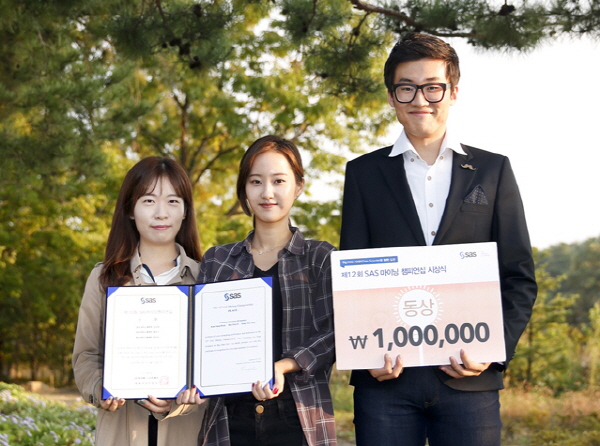A team of Department of Statistics wins 'Bronze Medal' at the SAS Mining Championship. The 3 members show off their talents as data scientists at a big data analysis contest.
[October 10, 2014]
“Leave big data analysis to us!”
YU (President Noh Seok-kyun) students showed off their talents as data scientists at a big data analysis contest. A team of students from the Department of Statistics won the bronze at the '12th SAS Mining Championship'. They are seniors Kin Sung-hyun (24), Bae Eun-ji (22) and Jung Min-jeong (22).
The 'SAS Mining Championship' is a data analysis and idea contest for college and graduate school students to foster data scientists who will lead the coming age of big data hosted by SAS Korea (CEO Cho Sung-sik), a business analysis software and service company, and it is the most prominent competition for college students with goals of becoming analysis experts.
This contest, which was co-hosted by SAS Korea and the Health Insurance Review & Assessment Service (Director Sohn Myeong-se, 'HIRA'), was joined by 750 college students in 250 teams around the country. Applications started in May and after first evaluations that assessed the accuracy of the analysis model and the second evaluation on presentations to assess the utilization, the YU Department of Statistics team won third place on the 30th of last month and received a 1 million won prize and plaque. They will receive priority when selecting the SAS Korea internship and they will also receive additional bonus when consideration for hiring new employees.
The theme of this contest was 'development of prediction model for areas to open hospitals' by analyzing the risk and predicting future sales of regions that desired opening of hospitals and clinics. The objective of this contest was to provide information to predict the risk of newly opening clinics from having to close down in the region and the predicted sales in the future for convalescent institutes in specific regions.
Participants collected data provided by HIRA and other public information needed for prediction analysis to deduce analysis results. In this contest, the fact that other modeling was deduced according to variables from outside data acted as an important variable. Participants selected and reflected information that they judged to have value to their team among the public data disclosed by Statistics Korea, National Health Insurance Service, and the Ministry of Land, Infrastructure and Transport. In result, the teams submitted different modeling results.
The YU team mainly used information related to convalescent hospitals provided by HIRA and regional demographic information of national statistic portals provided by Statistics Korea to develop their prediction model. Kim Sung-hyun who led the team said, "From the basic convalescent hospital information of HIRA, we analyzed the distance between hospitals using latitude and longitude to extract data from competitors and analyzed the number of residents, age, housing type, and number of insured persons per region according to Statistics Korea and analyzed accurate predicted sales and risk of closing."
Kim said, "I am attracted to the big data analysis that predicts the future and establishes strategies by extracting useful information from data," and added his aspirations to become a big data expert by stating, "After graduating I would like to find a job related to big data analysis to gain more expertise."










